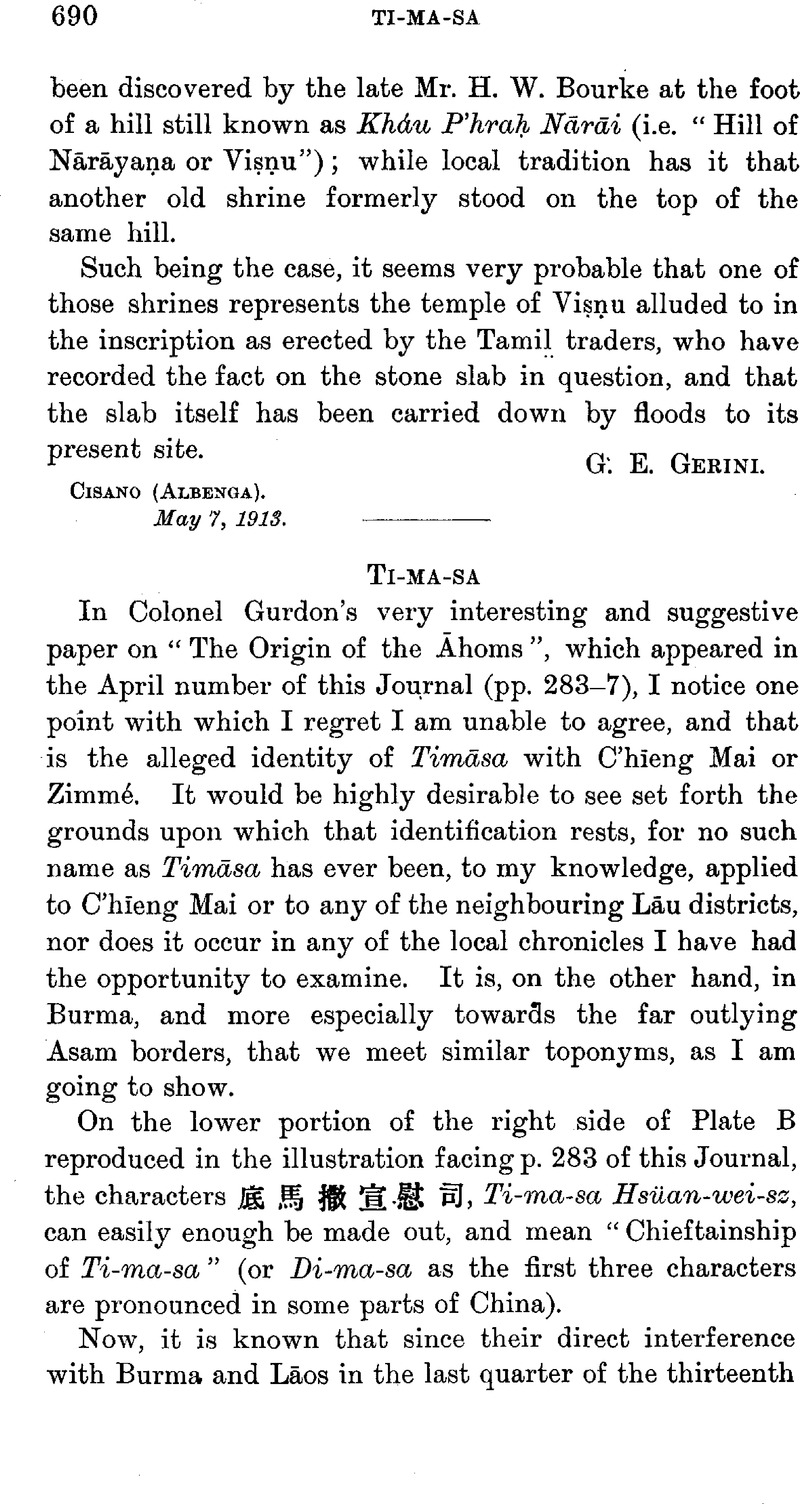No CrossRef data available.
Article contents
Ti-ma-sa
Published online by Cambridge University Press: 15 March 2011
Abstract

- Type
- Miscellaneous Communications
- Information
- Copyright
- Copyright © The Royal Asiatic Society 1913
References
page 691 note 1 C. Imbault-Huart enumerates six of these (four in Burma and two in Laos) at the beginning of the Chinese Ming Dynasty, i.e. on or soon after 1368 A.D. (see the Journal Asiatique, 1878, p. 142Google Scholar, n. 2); and E. H. Parker mentions seven in 1384 (see the China Review, xx, p. 394), of which four are in Burma.Google Scholar
page 691 note 2 According to Parker, E. H.'s Burma (Rangoon, 1893), p. 60.Google Scholar
page 691 note 3 See BEFEO. ix, 669Google Scholar, where P'ing-mien is tentatively located by E. Huber on the Upper Shwē-li (Nam Mao River, here called Nam Yang). But was not this the territory of the Lung-ch'wan Prefecture established in 1383?
page 691 note 4 The only term Ma-sa that I know of in Burmese toponymy is the one occurring in the name of the Kwe Masa River, in East Meiktila (in about lat. 20° 50′ N., long. 96° 30′ E.), which joins the Myittha near Pyin Nyaung.
page 691 note 5 See the Upper Burma Gazetteer, pt. ii, vol. i, p. 193.Google Scholar
page 691 note 6 See op. cit., pt. ii, vols, i, p. 198, and iii, p. 302. The present Ti-ma circle includes forty villages and the Ti-ma plain which stretches across the valley of the Nam Ti. The name is presumably derived from this stream, the Ti (Nam Ti).
page 692 note 1 Other presumably related toponyms occurring in historical accounts of Kachàr and neighbourhood are—
(1) Dima-ruā, the seat of a chief in the middle of the sixteenth century.
(2) Dimuriā, the seat of a chief subdued in 1524.
(3) Demera, a place named at about the same period. (See Gait, E. A.'s Koch Kings of Kámarúpa, Shillong, 1895, pp. 19, 25, 40.)Google Scholar
“The name Dimā remains unexplained,” remarked R. F. St. Andrew StJohn, in JRAS. 1897, p. 642.Google Scholar
Mr. Gait gives Hiḍamba or Hiṛamba as the literary name of Kachār (op. cit., pp. 26, 40); but I may quote on the other hand at least two authorities to show that, during at any rate the three centuries before last, that land was commonly known to the neighbouring nations (the Burmese in particular) as Lima, evidently a corrupted form of Dimā (whether this was meant for its historical capital Dimā-pur or for the hill tracts peopled by Dimāsa tribes). In fact, De Barros (dec. iii, lib. ii, ch. 5, p. 162; and dec. iv, lib. ix, ch. 1, p. 452, of the Lisbon edition of 1777) terms it Brema Lima (a designation so far, to my belief, unidentified), which seems to imply that it was then, or was believed to be, a Burmese possession, like his Brema Ova (Ava), etc.
Again, in a Siamese translation of a chronicle of Pegu and Burma, I find it stated that in 1826 the following north-western dependencies of Burma were ceded to the English, namely: (1) Arakan, (2) Vesāli (Assam, with perhaps also Jaintyā, see below), (3) Kasë (Maṇipur), (4) Alima (evidently De Barros' Brema Lima, i.e. Kachār). Burmese scholars should be able to check this list in the local annals and find what is the exact native spelling of the last toponym, transcribed in the form Alima in the Siamese translation. In the treaty of Yandabo (February 24, 1826), as printed in Crawfurd, 's Embassy to Ava (London, 1829, pp. 20–1Google Scholar of Appendix), Ak-ka-bat is the term employed in the Burmese version to denote Kachār, while Vesāli is taken to mean Jaintyā (cf. also p. 490 of the same work). The former requires explanation and, if wrongly transcribed, correction. No sign is to be found of it, nor of anything resembling Alima, in Judson's Burmese-English Dictionary or other works of reference on Burma.
page 694 note 1 Cf. BEFEO. ix, p. 652Google Scholar, footnote.
page 694 note 2 Not 1408 as stated on p. 285 of this Journal, unless the month (the number of which is illegible on the reproduction of the obverse of Plate A) was the eleventh or twelfth, in which case the date would fall in January or February, 1408. Careful reference to the metal plaque may enable one to decipher the number of the month as well as the day, and thereby to determine the precise date of that interesting document.




